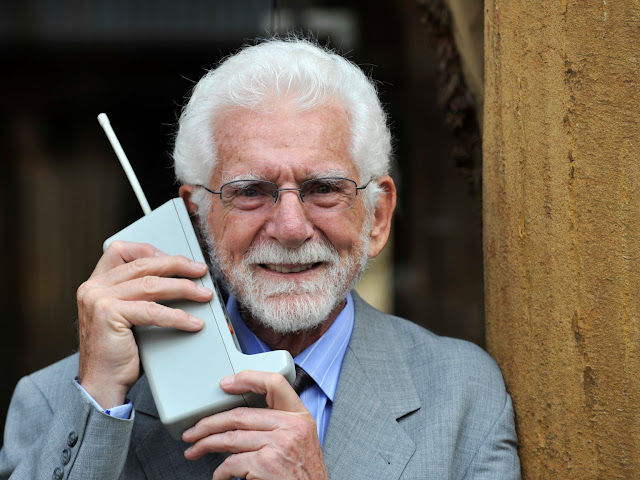What 15 groundbreaking inventions looked like when they first came out
What 15 groundbreaking inventions looked like when they first came out
Lets have a look at how the World's first groundbreaking inventions looked like when the first came out..
- Bicycles were made out of wood when they were first invented in 1817.
- Before electric refrigerators, "iceboxes" were made of wood and filled with ice.
- The first electronic digital computer took up an entire room.
In just a few years, mobiles phone have gone form bricks which take 10 hours to charge to an all advanced phones, camera, credit card, email system, computer, gaming console and more.
Computers have also gone from taking up an entire room to sitting on our laps and palms
If we talk about house hold items they have also shown great advancement in their field of technological transformation.
Here are the 15 groundbreaking Inventions and how they looked like when they first came out..
The First Microscope:
 |
. It is not clear who invented the first Microscopes. Microscopes emerged around 1950's.
. Two different sources are credited with the invention of the microscope: Hans Lippershey, who filed the first patent for a telescope in 1608, and Hans and Zacharias Janssen, a father-son team who wrote about microscopes in the 1590s.
Bicycles:
. Bicycles were made of wood when they first came out
. First Bicycle invented by Karl von Drias required drivers to push contraptions by foot. The paddle were added in 1860s via new inventions.
Refrigerators:
 |
| An Icebox 1910 |
. Before electric refrigerators, "iceboxes" were made of wood and filled with ice.
. Iceboxes used various materials to keep the ice frozen and the food inside cool, including cork, tin, zinc, sawdust, and seaweed. In 1835, Jacob Perkins patented a refrigerator with a liquid ammonia vapor-compression cycle.
The first light bulb:
 |
| Edison carbon filament lamps in the early 1880s. |
. Thomas Edison is often credited with inventing the light bulb in 1879, but other inventors played a part in its creation.
. While he did patent the first commercially successful light bulb in 1879, its history dates back to 1800 with Italian inventor Alessandro Volta's first electric battery called the voltaic pile. Humphry Davy also invented the first electric lamp in 1802.
Kinetograph:
 |
. George Eastman and Thomas Edison helped create the film industry with their motion picture equipment.. Edison patented the kinetograph and the kinetoscope in 1891. Eastman invented the camera box in 1888 and roll-film in 1889.
Telephone:
 |
Vaccum Cleaner:
 |
| The first vacuum in 1901. |
. The first vacuum cleaner was patented by inventor Hubert Cecil Booth in 1901.
. The first vacuum cleaner didn't suck dirt up — it just blew it away with compressed air. Upright vacuum cleaners with bags on a stick followed in 1907, the brainchild of William Henry Hoover.
Washing Machine:
 |
| The Thor washing machine, invented in 1908. |
. The first electric washing machine also included rollers to wring wet clothes out.
. Alva John Fisher invented the electric washing machine in 1908 and patented the design in 1910. It got the name "Thor" from the Hurley Machine Company of Chicago.
Television:
 |
| A television in the 1930s. |
. The first television set called the Octagon was made by General Electric in 1928.
. Before it became the center of American living rooms in the 1950s and 1960s, the Octagon only played one show called "The Queen's Messenger."
. Microwaves were invented by accident while engineer Percy LeBaron Spencer was testing magnetrons.
. Magnetrons are " vacuum tubes that produce microwave radiation and are used in radar systems," according to LiveScience. Spencer noticed that a chocolate bar in his pocket melted while he was testing them. He invented the microwave by building a metal box around them since microwaves can't pass through metal, and found that the result could heat food faster than ovens. He filed for a patent in 1945.
Digital Computer:
 |
. The first electronic digital computer took up an entire room.
. ENIAC (Electronic Numerical Integrator and Computer) was completed in 1946 and cost $400,000 to build. The US government used it during World War II to perform calculations for the construction of a hydrogen bomb.
Video Tape Recorder:
 |
. The first video tape recorder was invented by Charles Ginsberg in 1951.
.The first video recorder sold for $50,000 in 1956.
Satellite:
 |
. The Soviet Union launched the first satellite, Sputnik I, in 1957.
. Sputnik I was about the size of a beach ball and orbited the Earth in 98 minutes. Its launch set off the space race between the US and the Soviet Union.
Cellphone:
 |
. Motorola developed the first handheld cell phone in 1973.
. The cell phone was the size of a brick and took 10 hours to recharge.
The First Website:
 |
. The first website went live on August 6, 1991.
. Designed by Tim Berners-Lee, the site provided information on the World Wide Web project. The URL was http://info.cern.ch/hypertext/WWW/TheProject.html.



Comments
Post a Comment